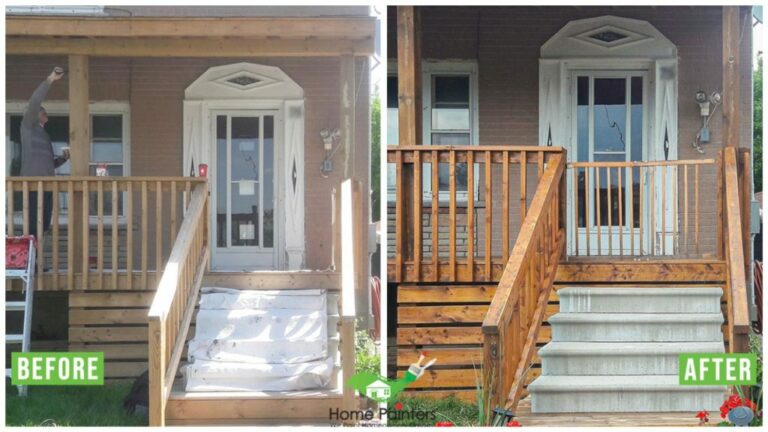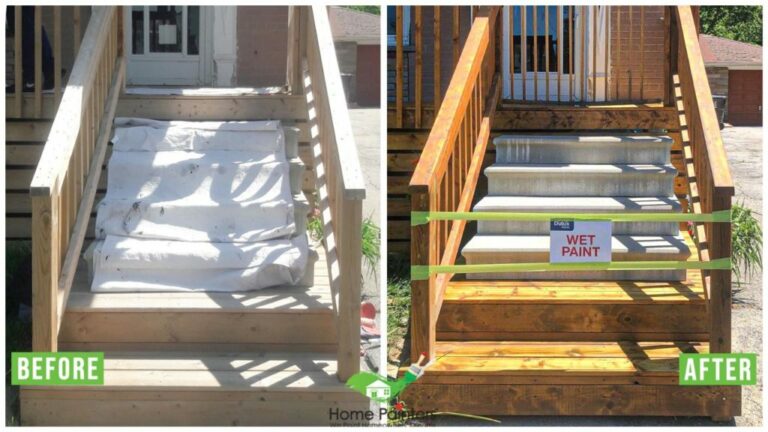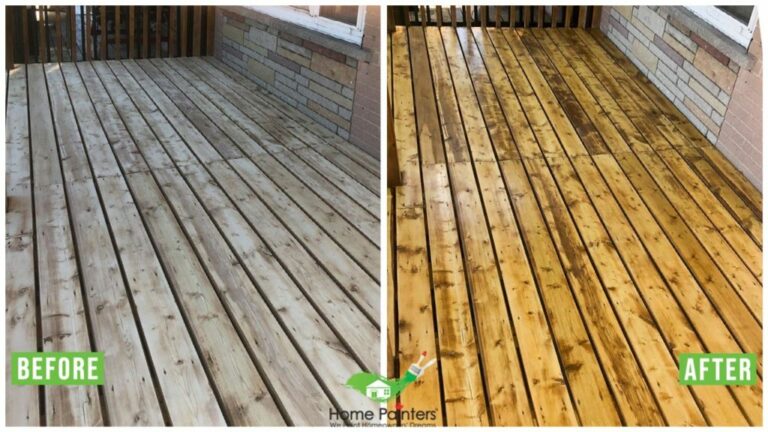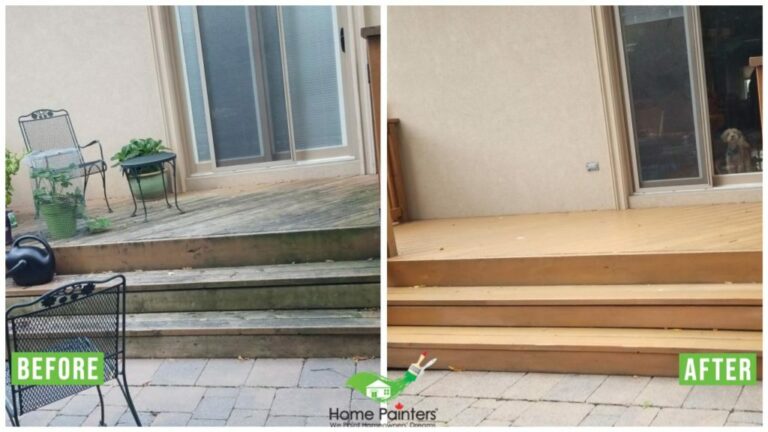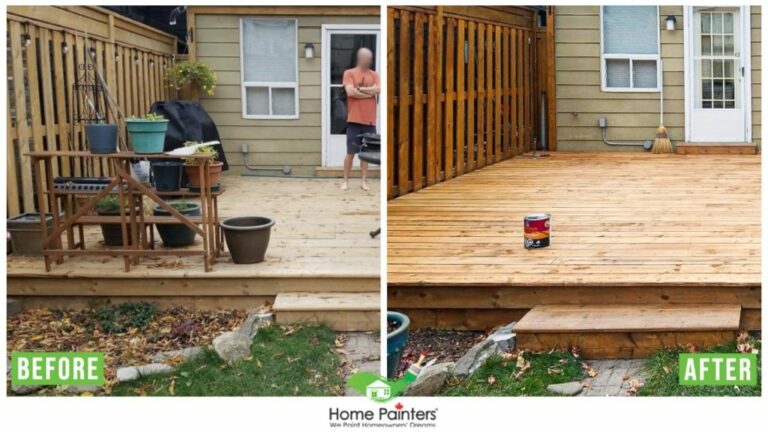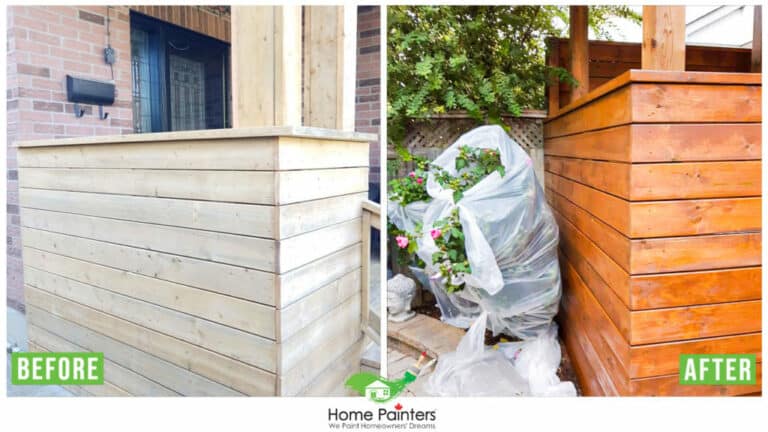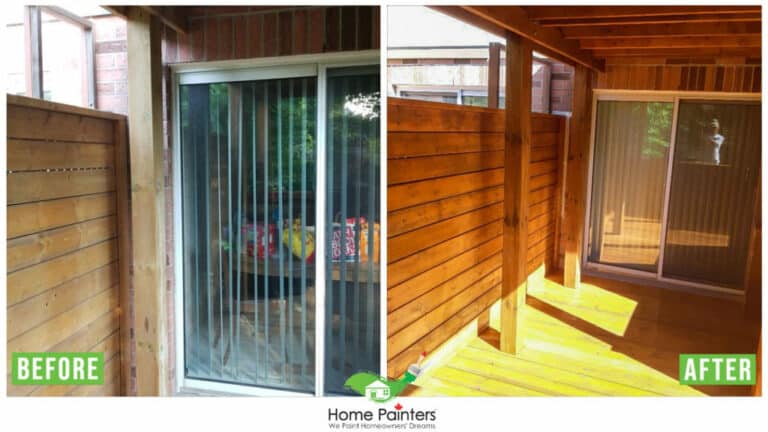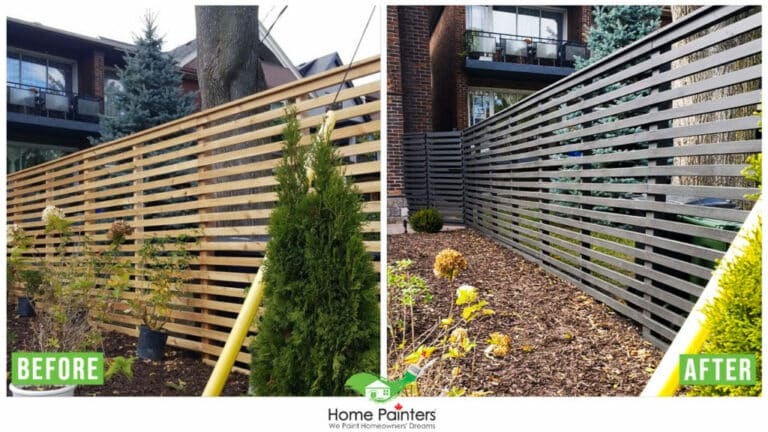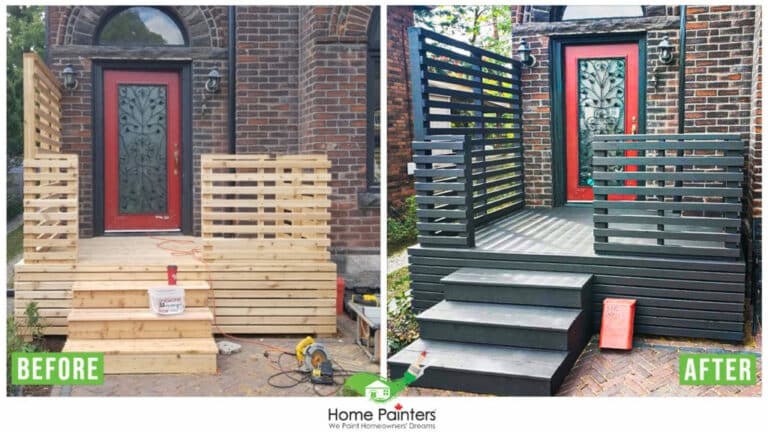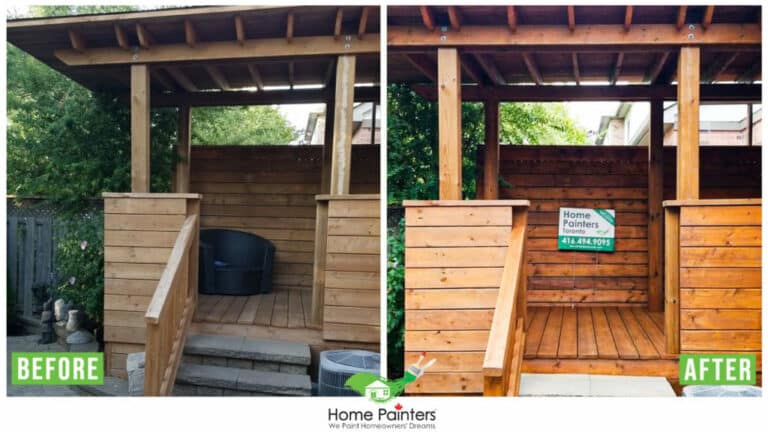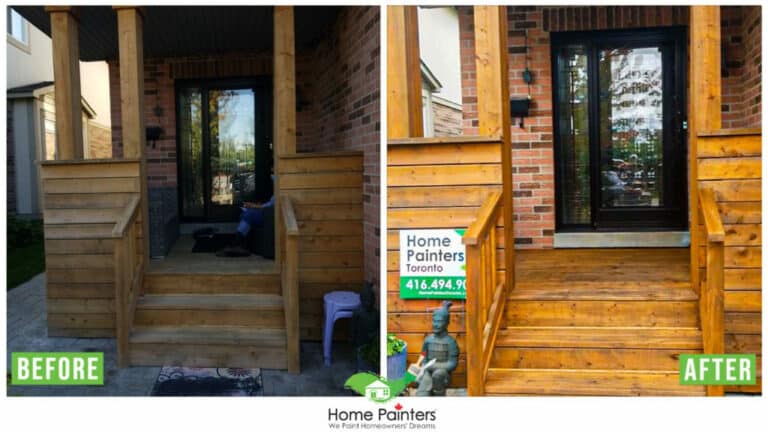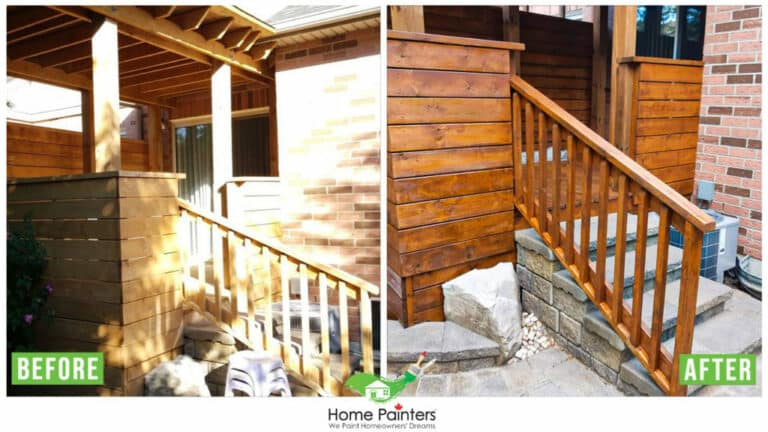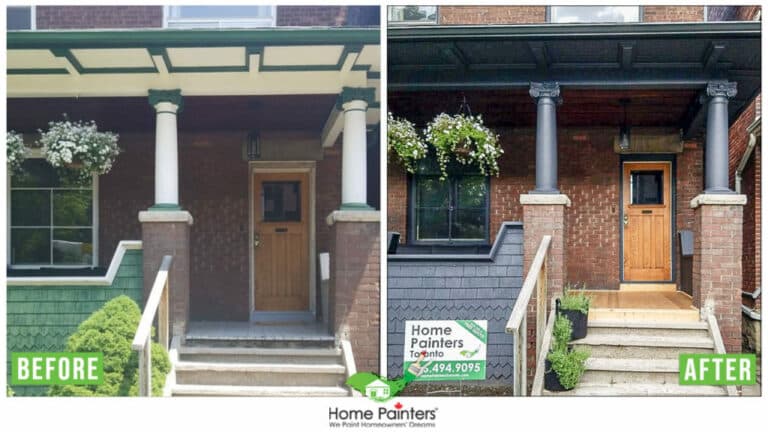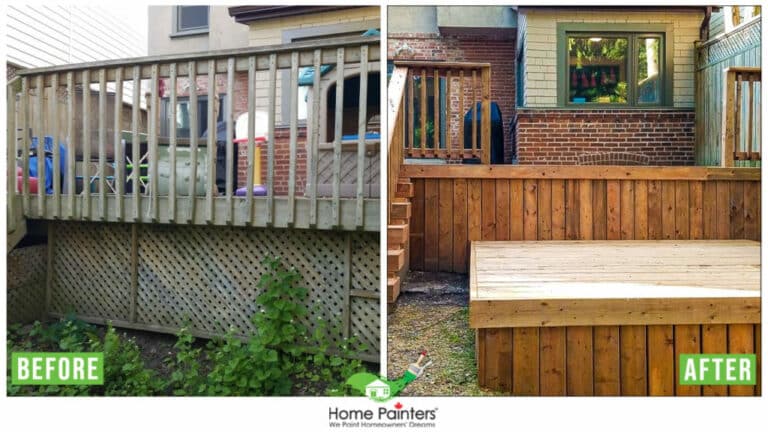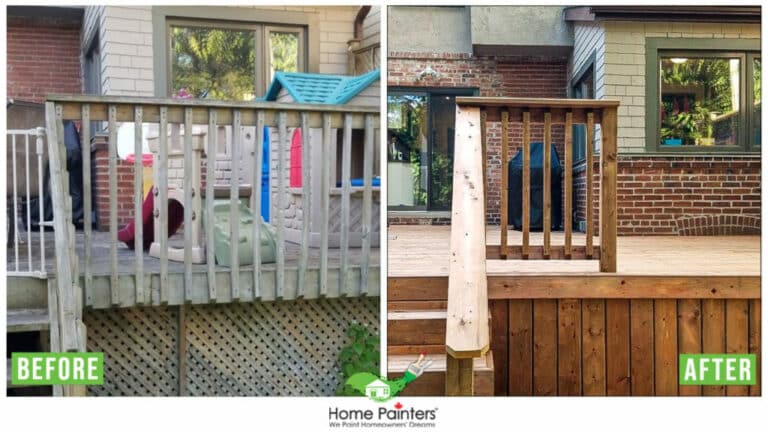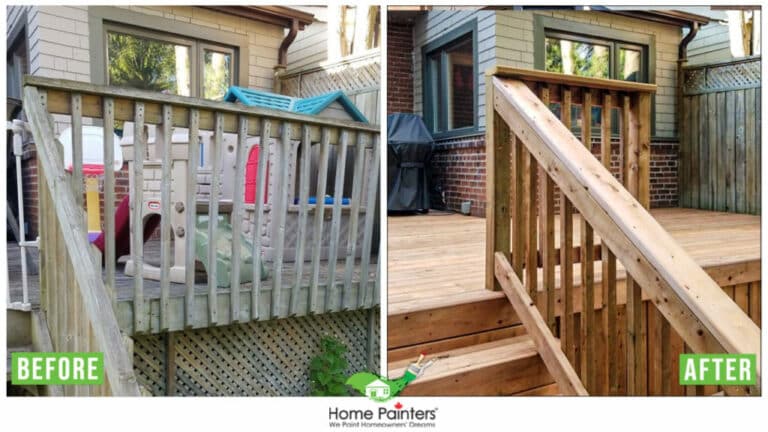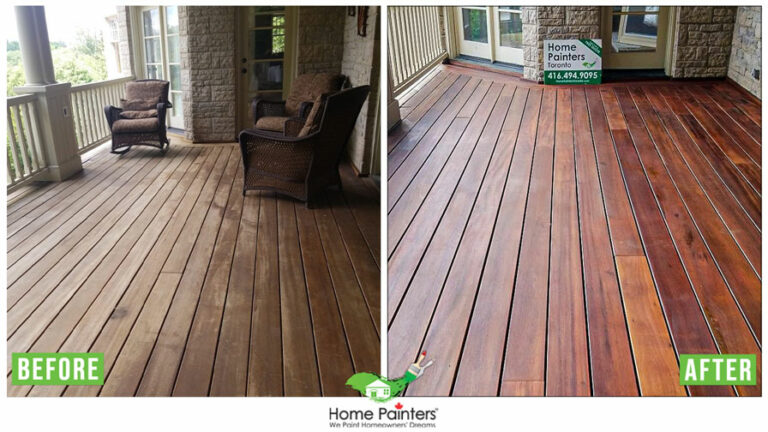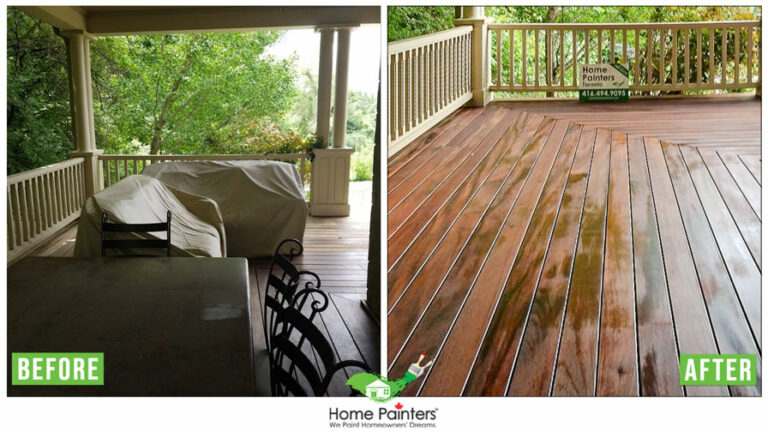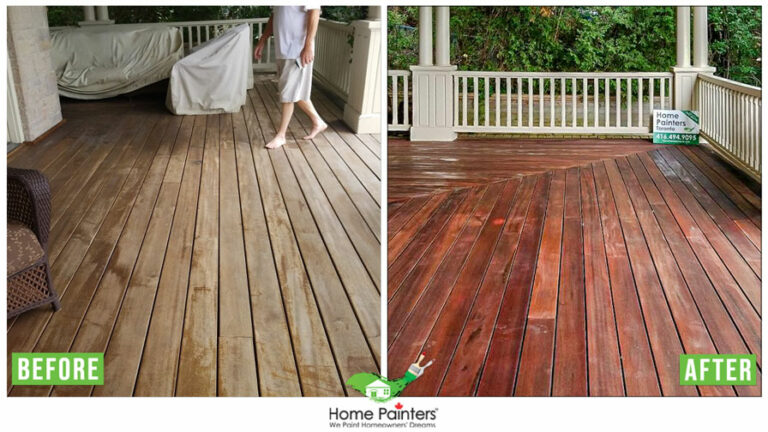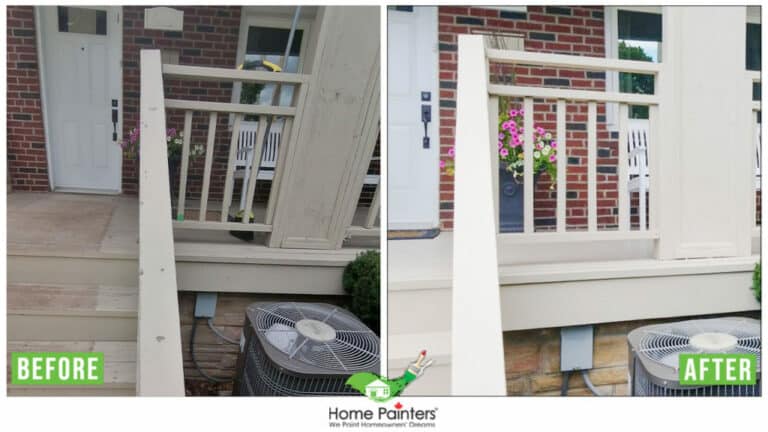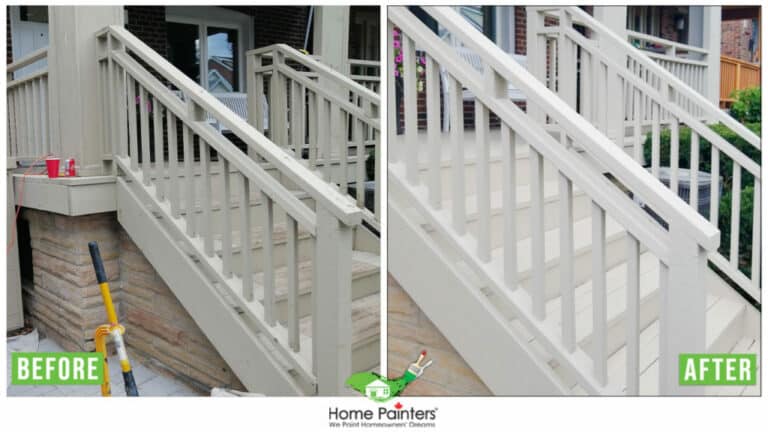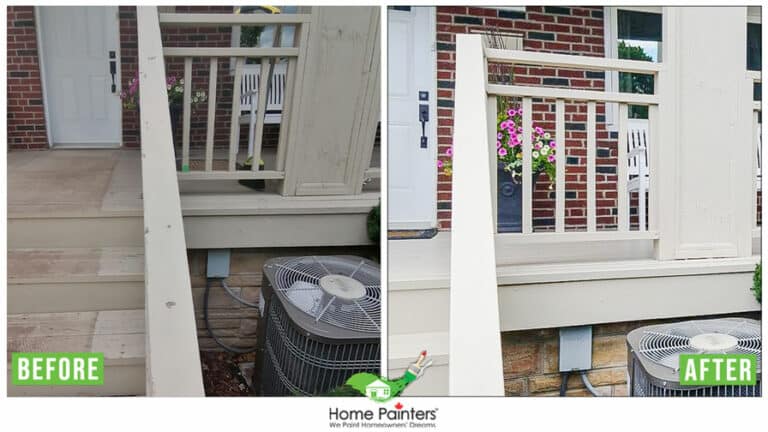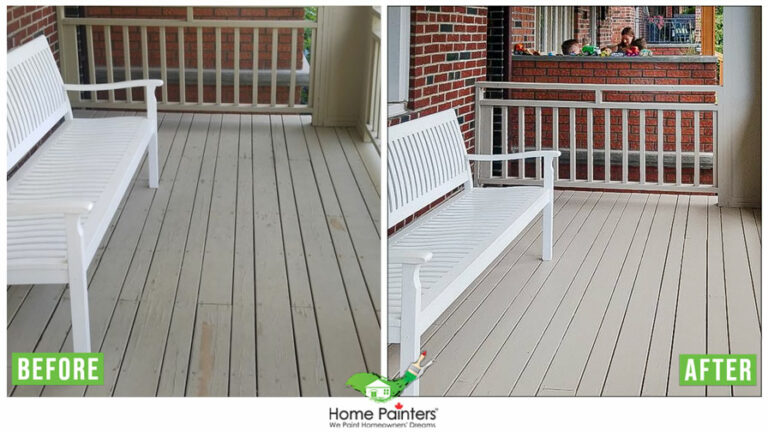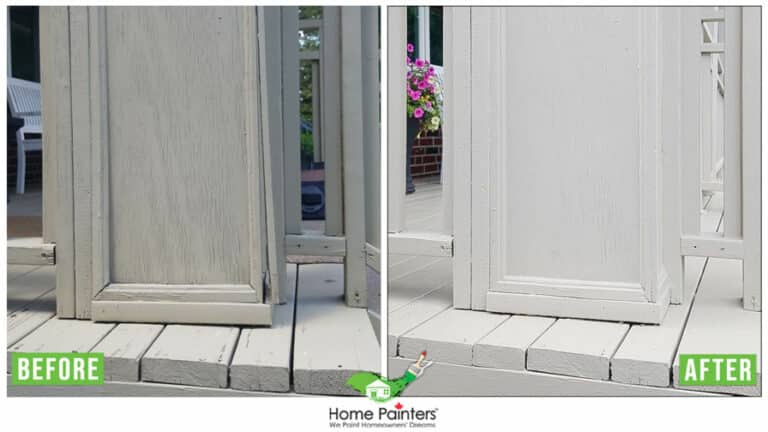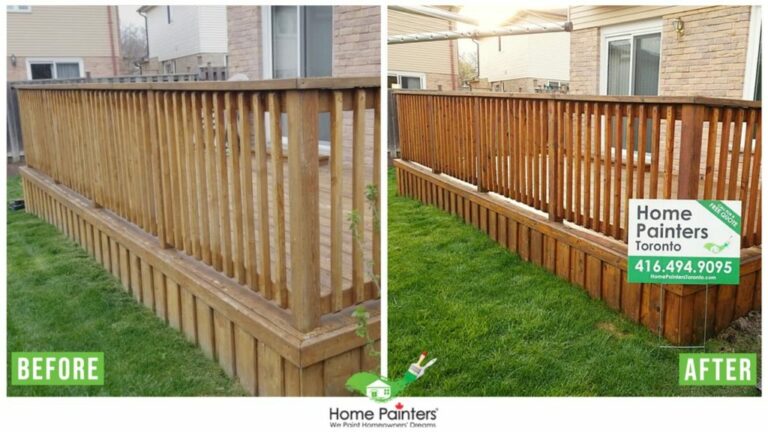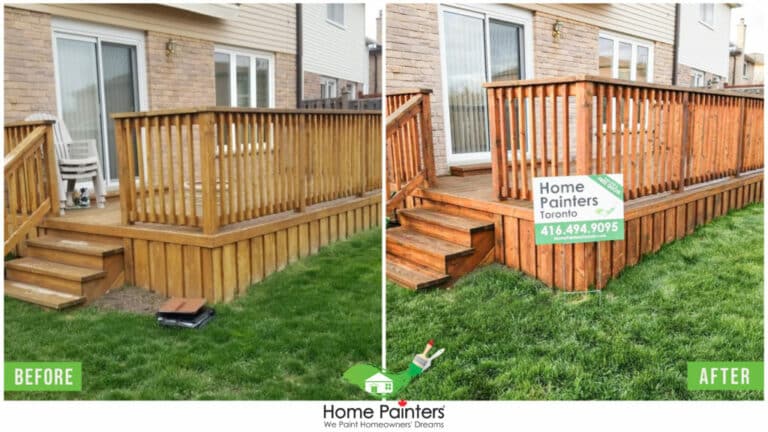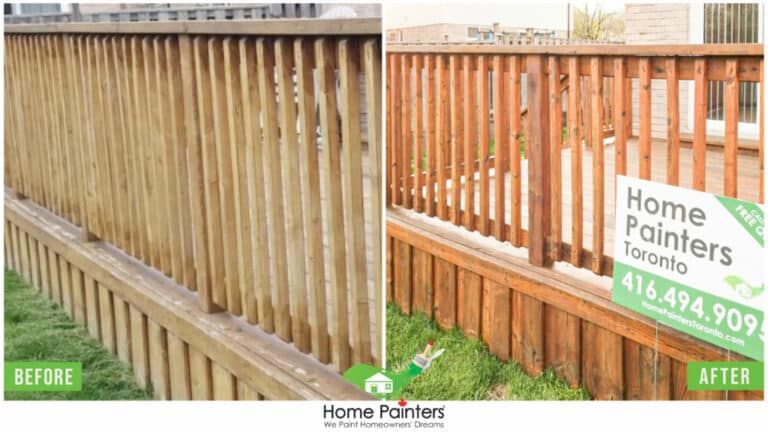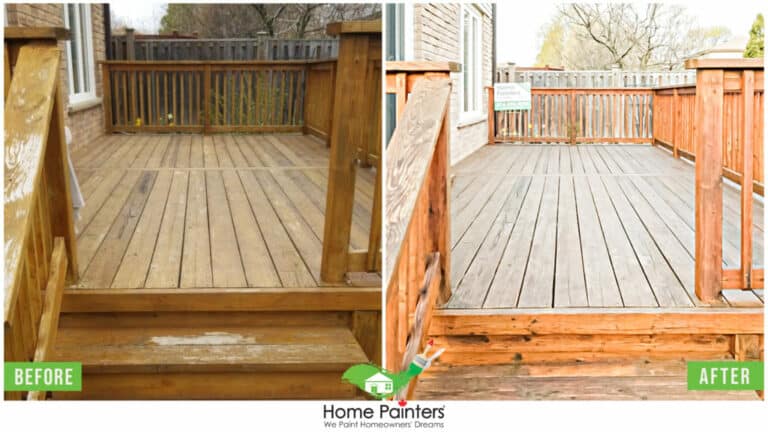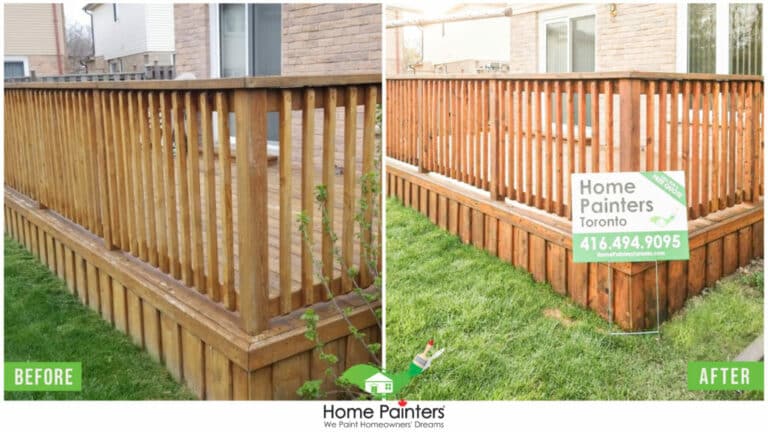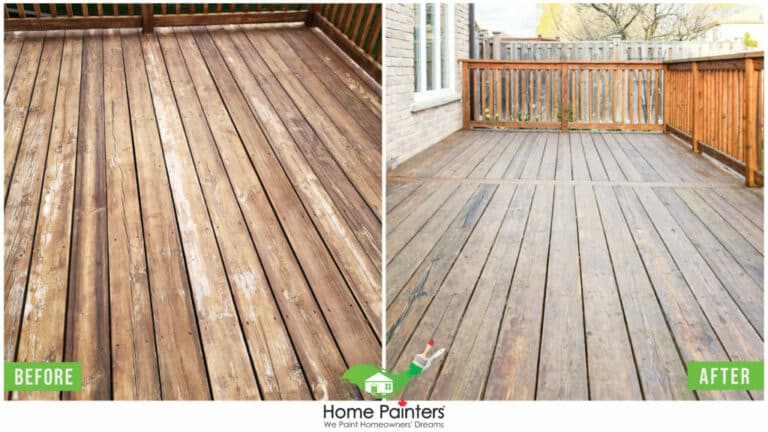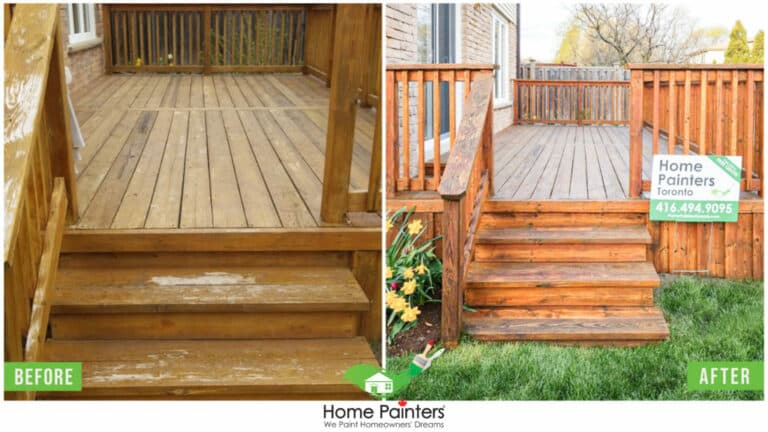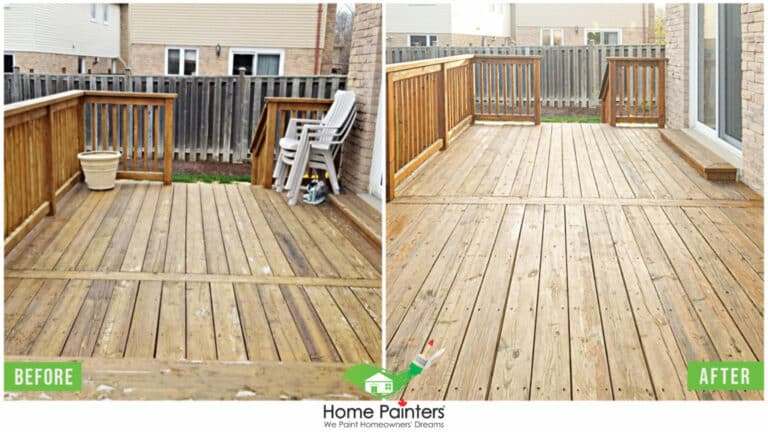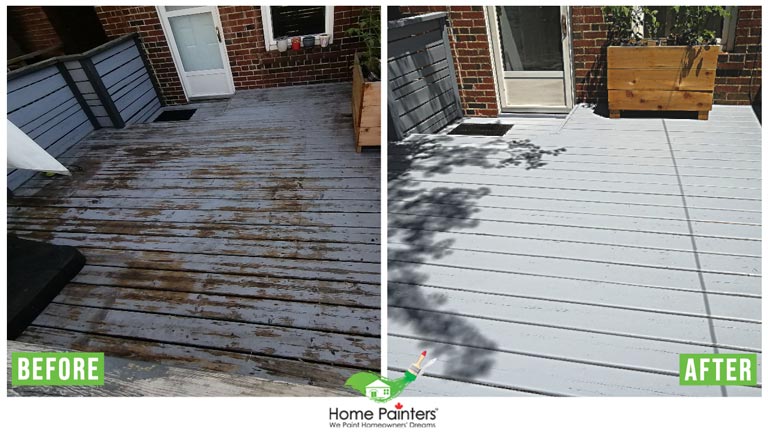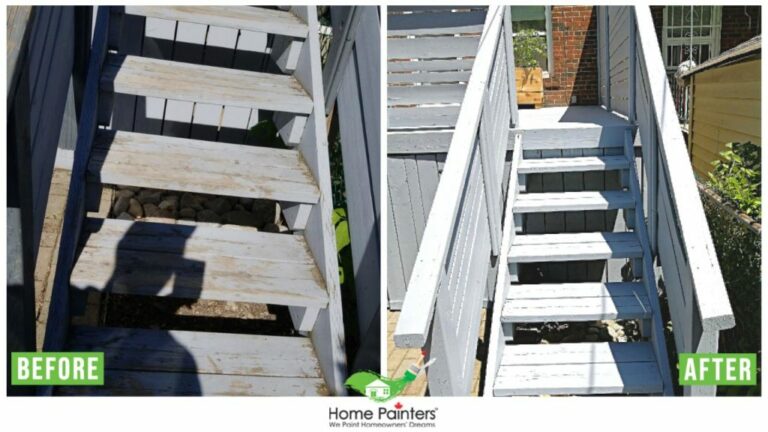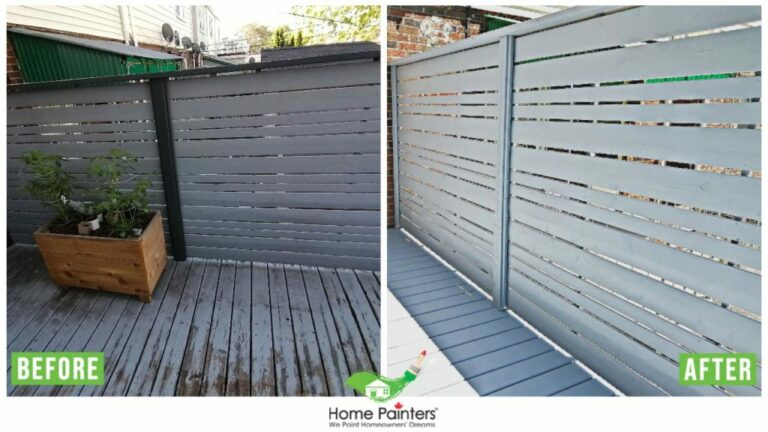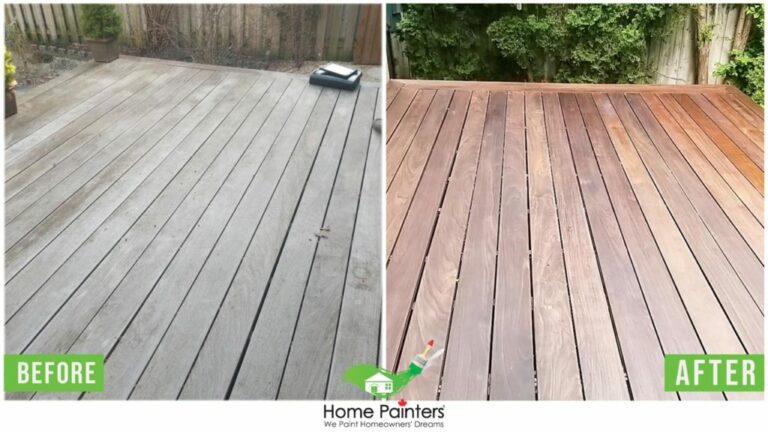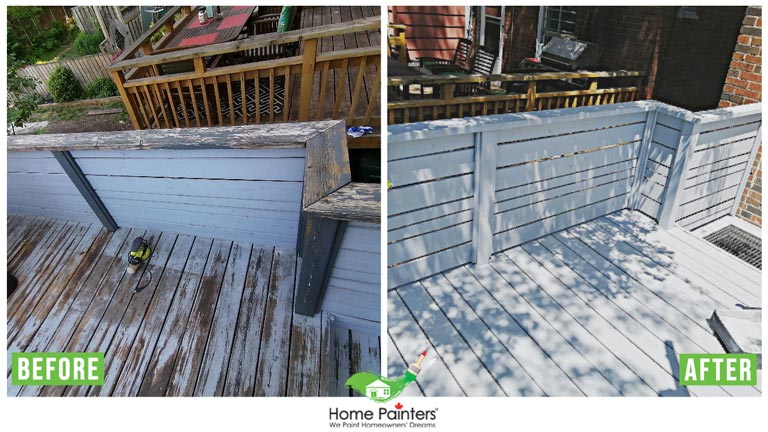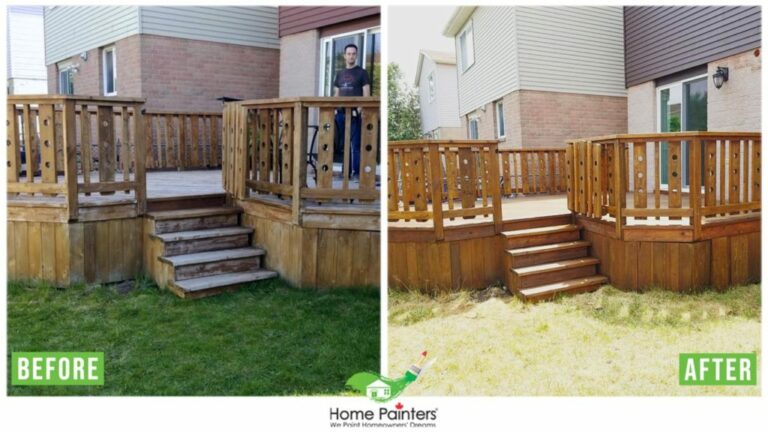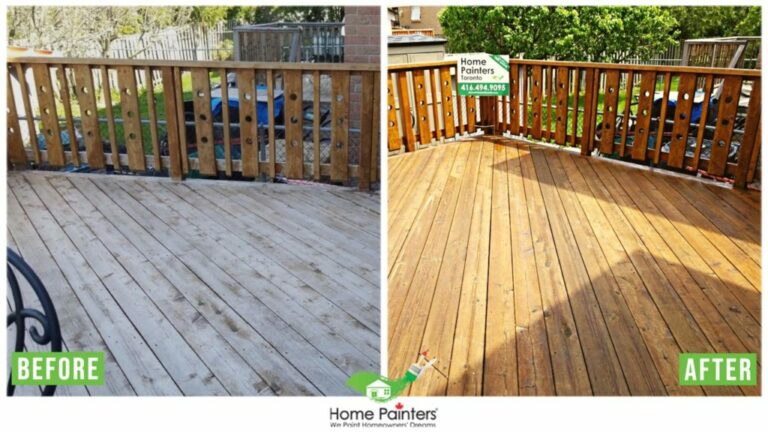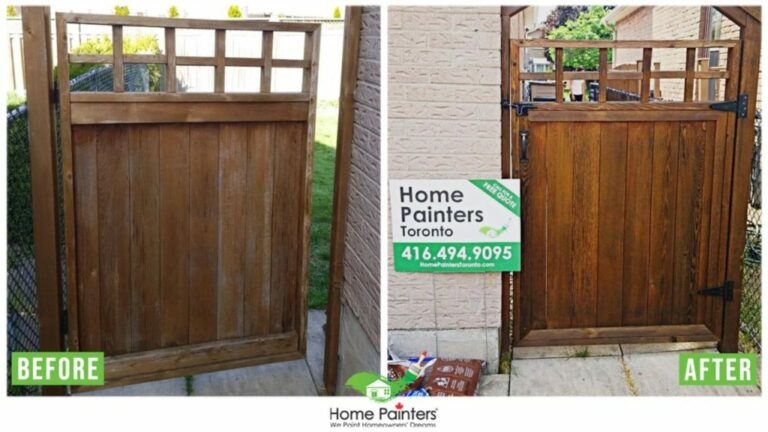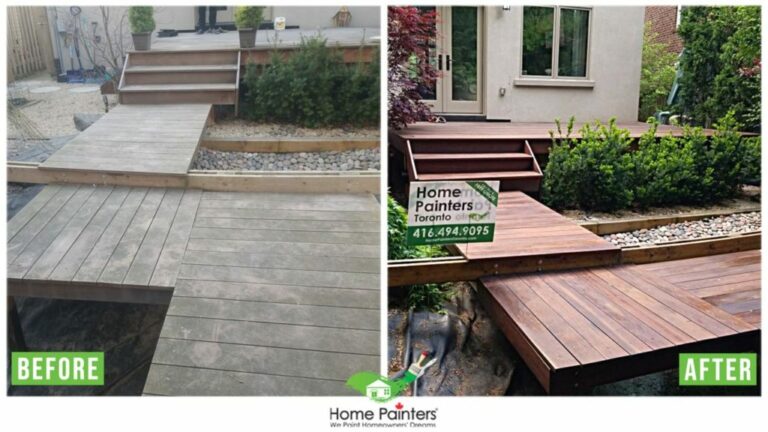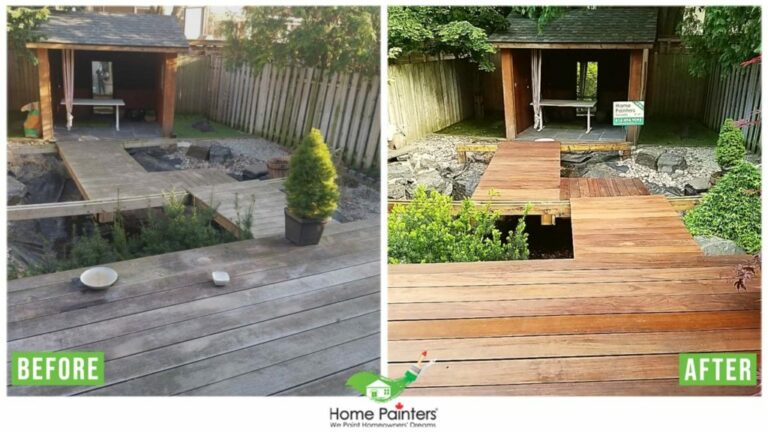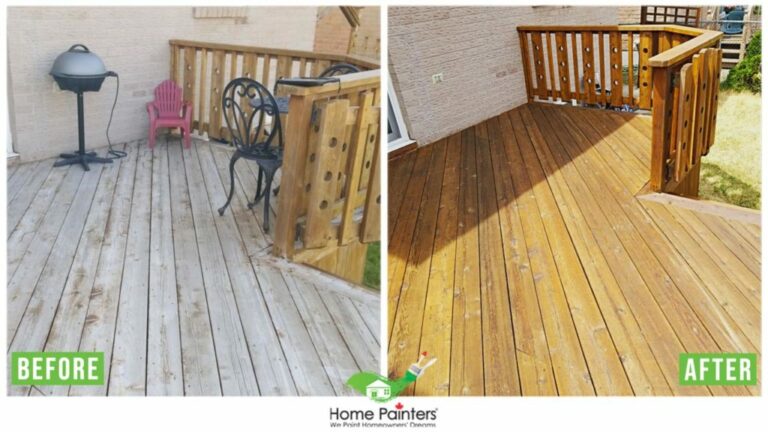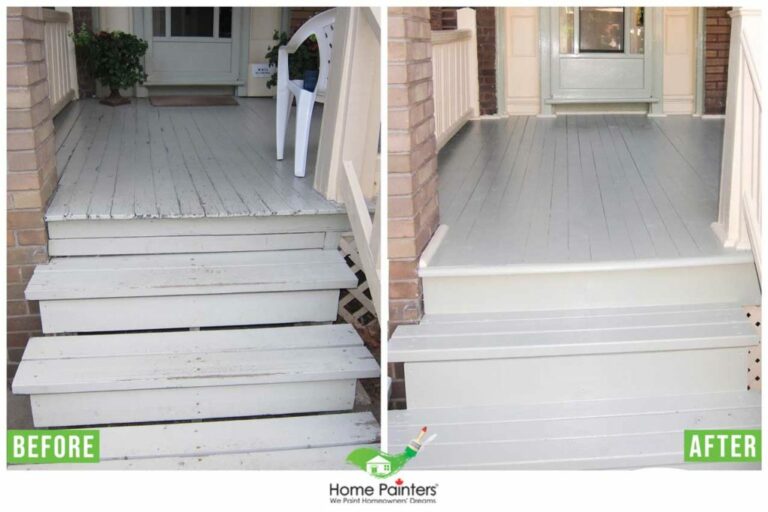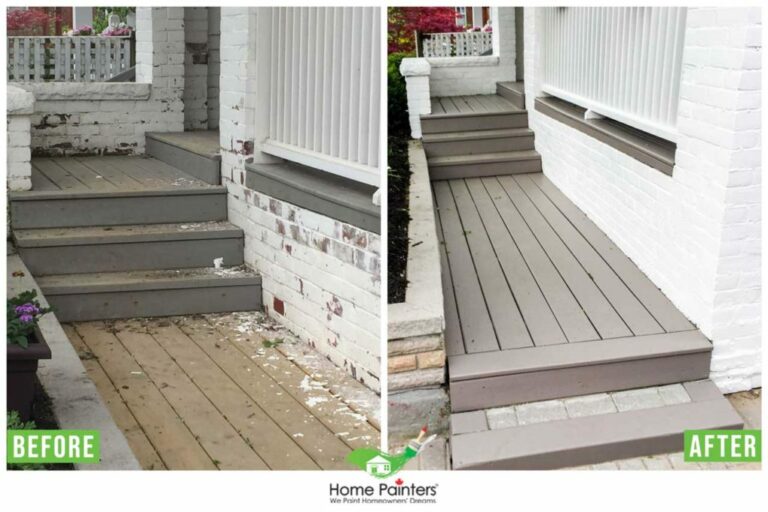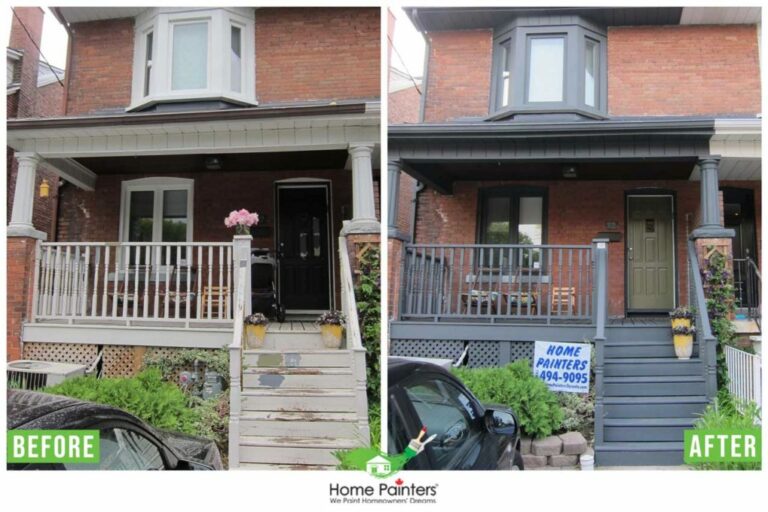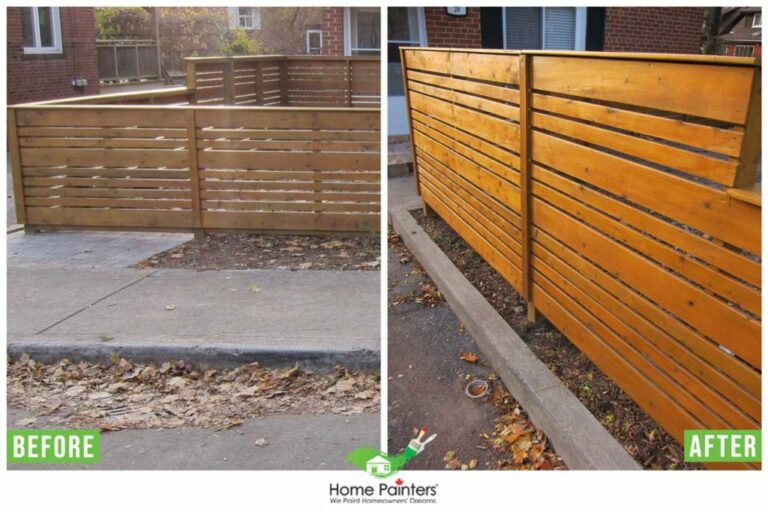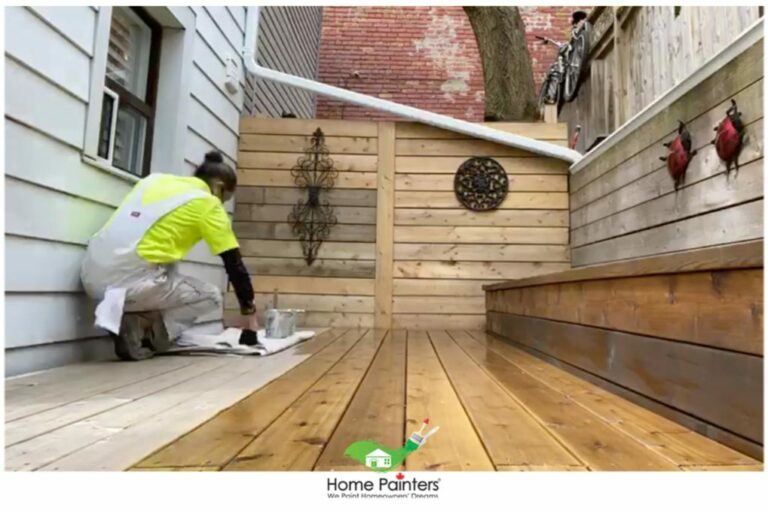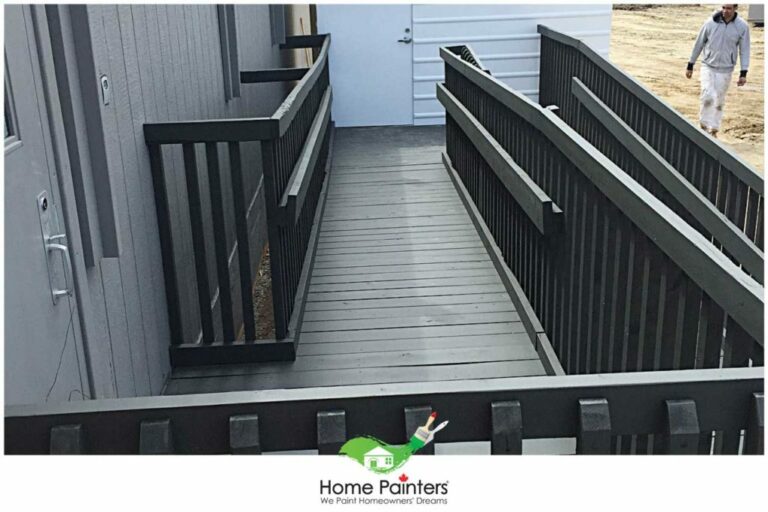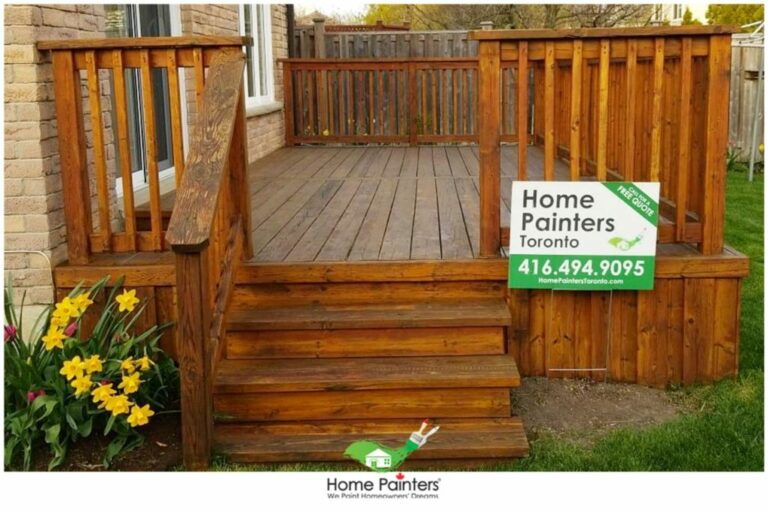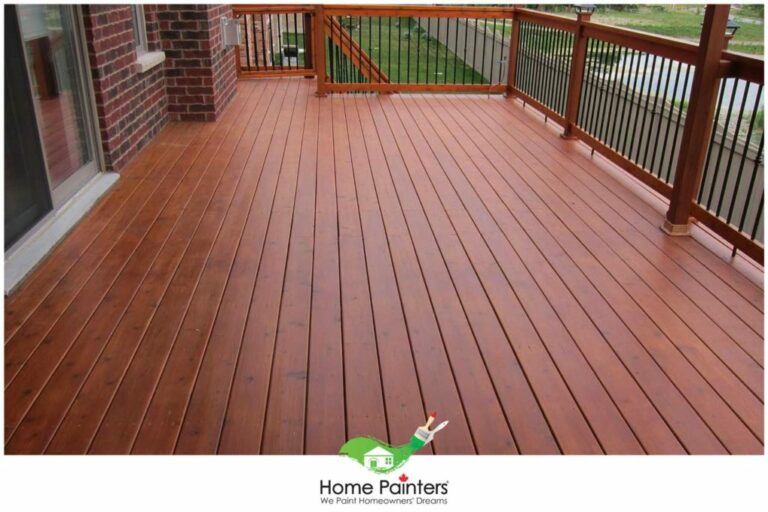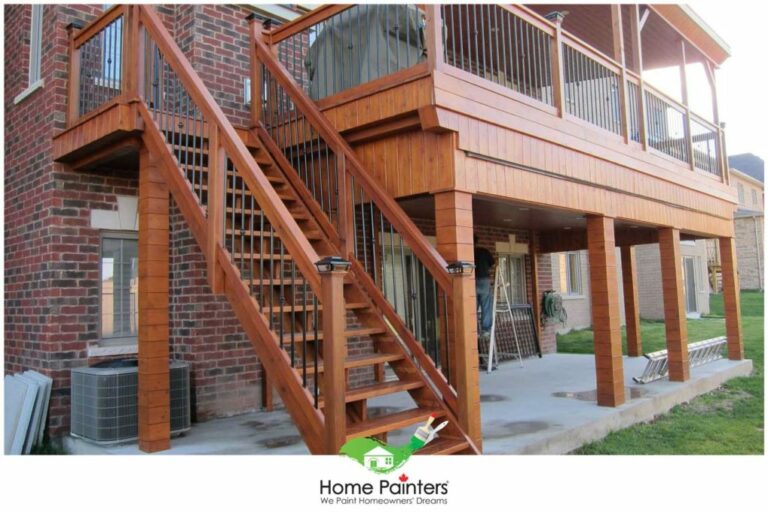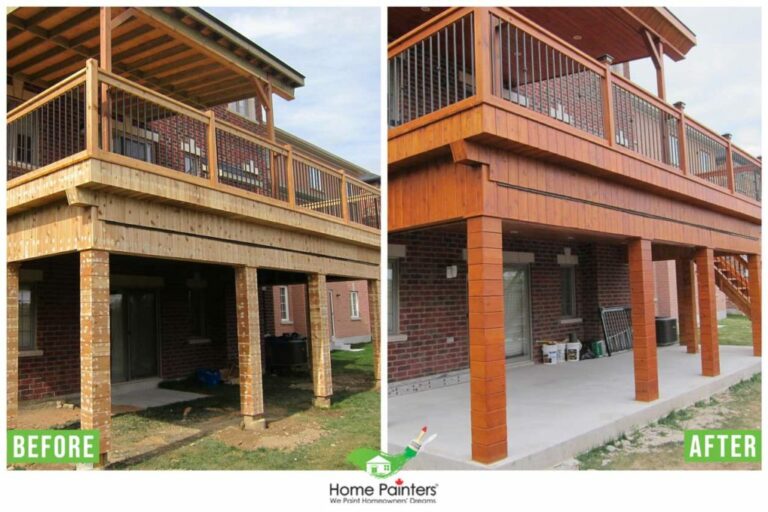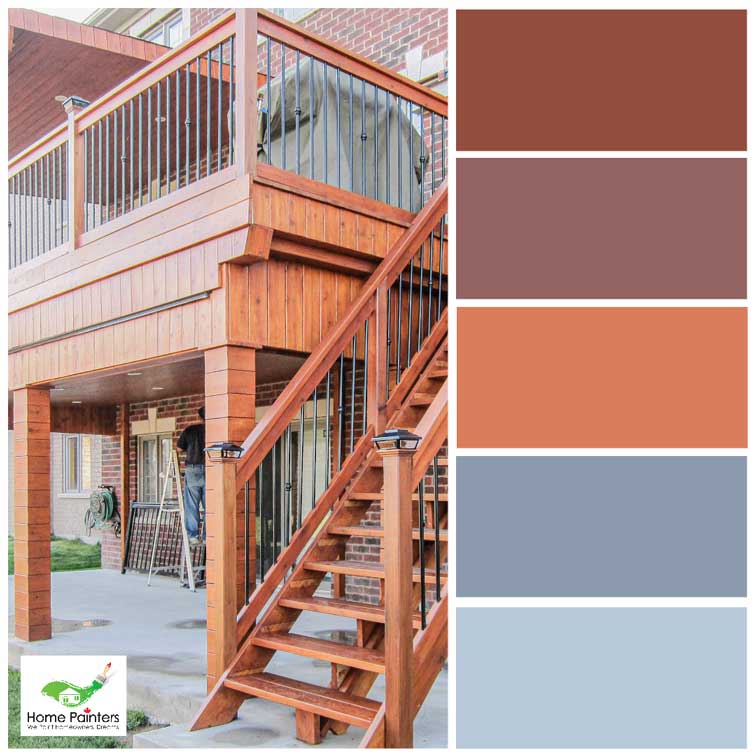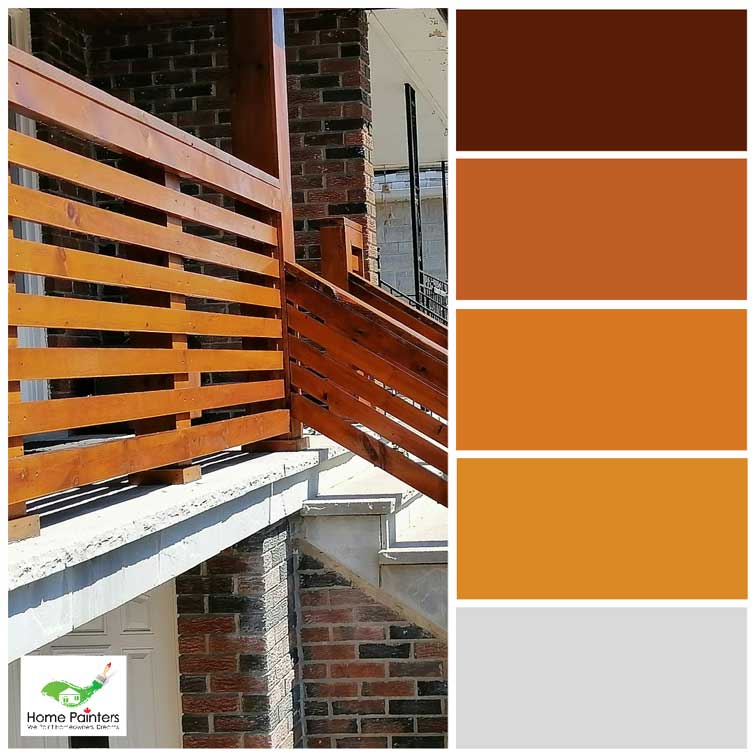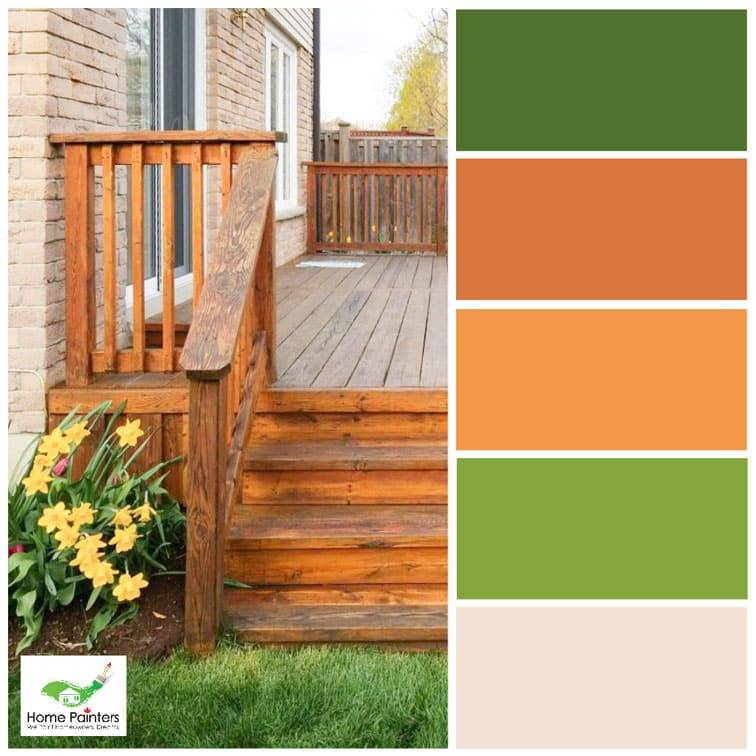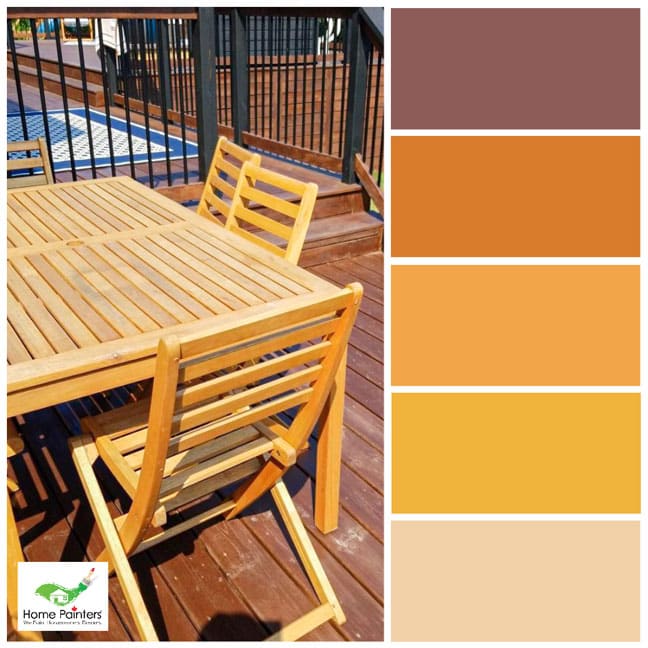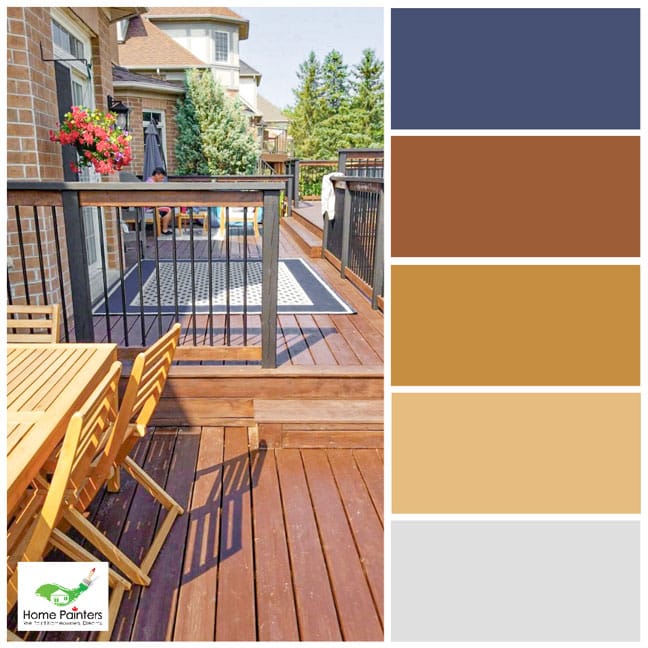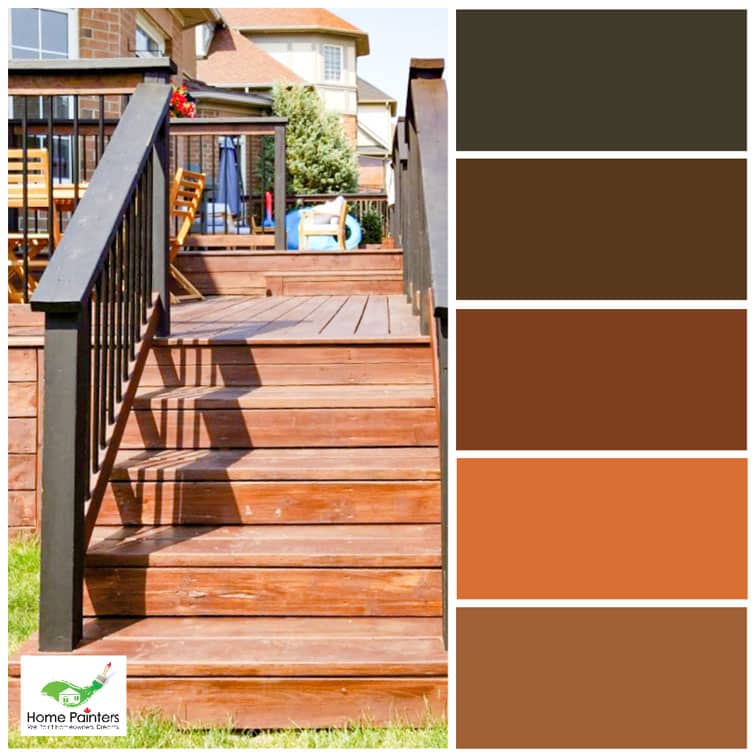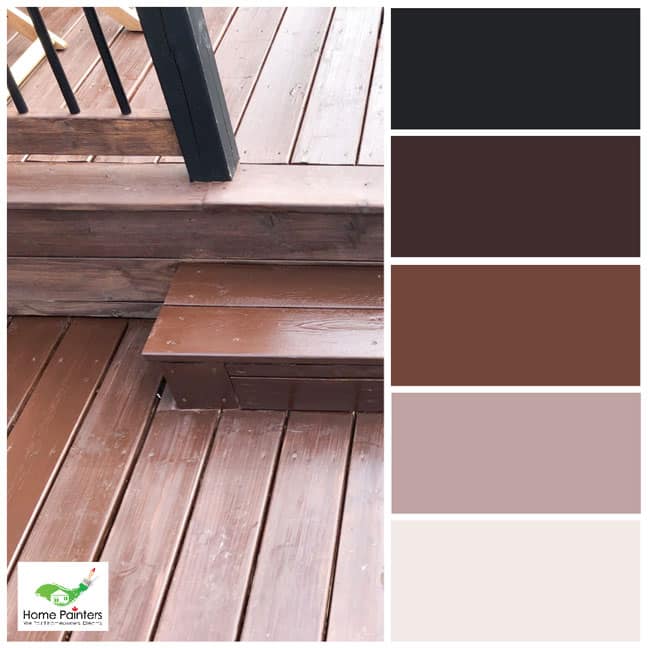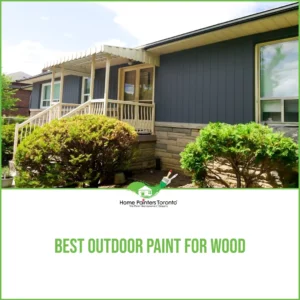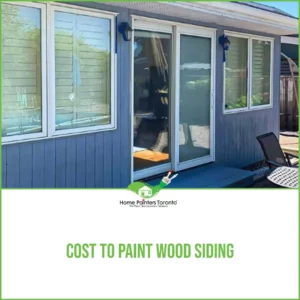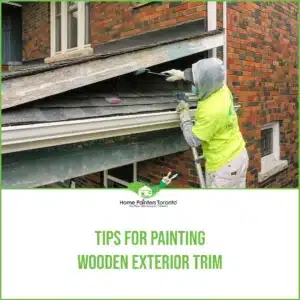
It’s that time of year again—summer!—when we get a lot of questions about outdoor wood painting. This is probably because more people take pride in their homes and want to beautify and protect their most prized investments!
In general, wood is the most common material used in Toronto to build homes in the past 100 years. It’s elegant, durable, and lasts for many years. But at the same time, it can get damaged by the weather elements if not properly maintained. Especially given the harsh extreme weather conditions in Toronto.
We’ve compiled some of the most common questions we get from homeowners, along with answers, to help you better understand this kind of exterior painting and ensure your outdoor wood is in top shape.
How Do I Paint Wood?
Here’s an overview:
1. Make sure the weather is good.
The weather has a significant impact on this process. So, ensuring no storms or other extreme conditions is essential before you start painting. Good weather means it should be at least 10 degrees outside and not raining.
Outdoor wood painting is best when the weather is nice and sunny, and you’re not dealing with rain or wind. As a result, your paintwork should hold up much longer than expected. The paint on your wood may break and peel if it endures severe weather.
2. Clean the surface.
So once you have good weather, you only need to wipe the surface clean.
But if algae or fungi are growing on the paint, you should scrub it with a sponge—or even better, wash it down with a hose.
3. Scrape and sand.
You then need to scrape down the flaking paint areas. Sandpaper can also be used to smooth over rough scaling areas, as well as rough surfaces.
This is another process how to strip paint from wood or other dirt buildup and will help ensure the new coat of paint adheres to the wood.
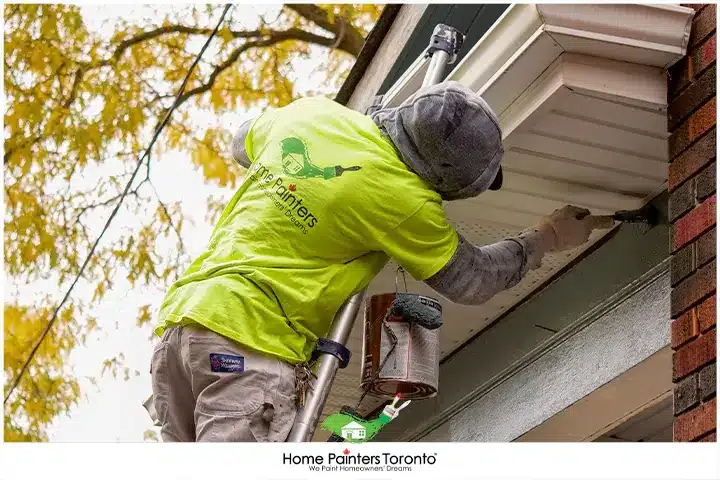
4. Caulk the cracks where necessary
Exterior Caulking can seal out water and moisture and keep bugs out as well. If cracks in the wood require caulking, use caulk to fill them in before applying your paint.
Otherwise, those cracks may cause problems when water builds up inside the wood.
5. Prime and paint
Now that your surface is clean, caulked, and sanded, you can prime and paint. Most paints now are two-in-one primers, meaning they will cover most surfaces unaided without primer. However, if the surface is terrible or of a unique material—for example, metal or bare wood—it’s safer to prime it before painting over it.
So, how many coats of paint for exterior wood should you apply? It depends on the type of paint, but as a general rule of thumb, most experts recommend two coats of paint should be sufficient.
What Outdoor Wood Paint Should I Use?
What paint finish is best for wood?
The answer to this question depends on what you’re painting and what you want the surface to look like. Several outdoor paints for wood are available today in various finishes.
- For example, if you’re painting a wooden garage door, Satin or at least a low-lustre finish is best. This finish will help prevent discoloration from sun exposure and fading, which could occur if you use a high-gloss finish.
- On trim and windows, use a flat, matte or low-lustre finish. These give a classy and modern look while remaining durable. However, Pearl, semigloss, or Satin on trim is a little too shiny, making it look older.
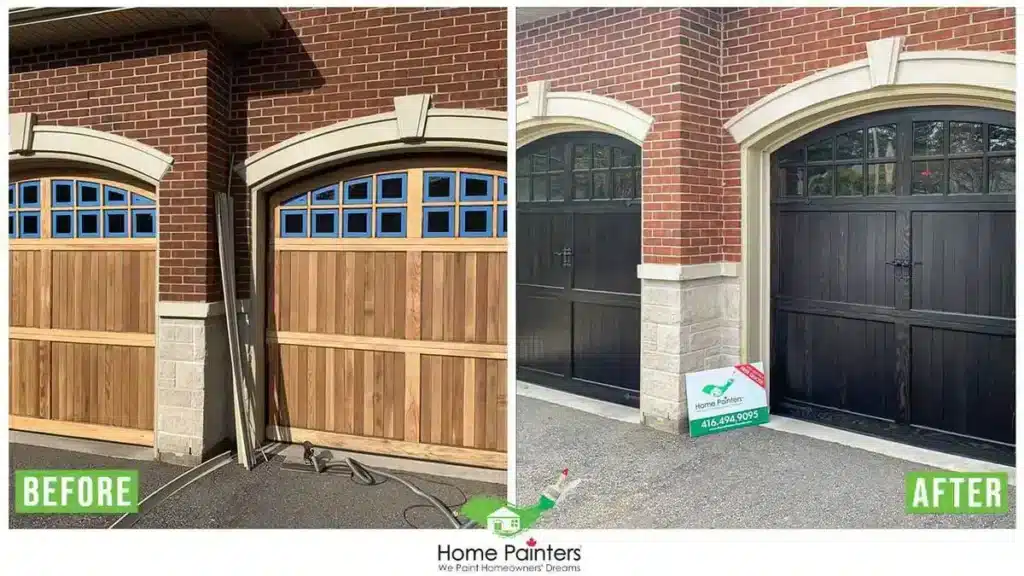
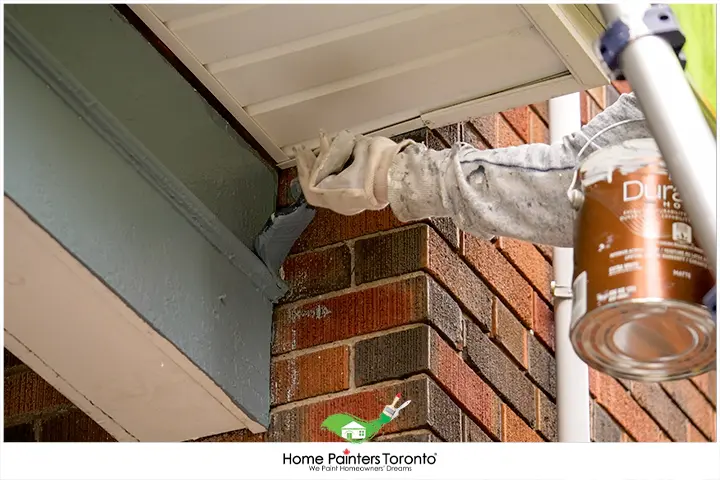
What are the best exterior wood paint brands?
A wide range of different brands and types of paint are available on the market today. Some of the top brands include:
- Sherwin Williams Duration
- Sherwin Williams A-100 Exterior Acrylic Latex
- Sherwin Williams Solo
- Benjamin Moore Ultra Spec
- Benjamin Moore Regal
- Benjamin Moore Ben
These are all our top picks for exterior wood paint. Each brand is known for its high-quality products, and we highly recommend them. The trick to finding the best paint for wood is to find a brand that works best for you and matches your needs.
How Should I Paint Wood? Should I Use a Brush, a Roller, or a Sprayer?
The best way to paint wood depends on the surface.
• For smooth surfaces like wood siding, you can use a sprayer. Brush and roller work as well.
• A brush or roller is more effective for rougher, narrow surfaces like windows, trim, and door frames.
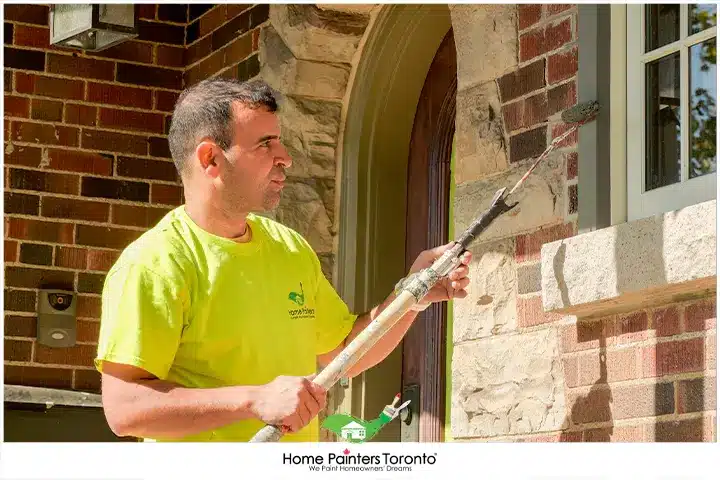
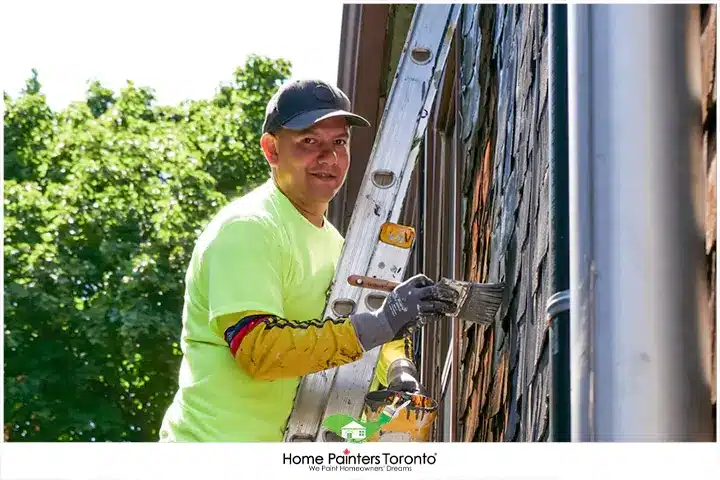
Painting wood requires a brush or roller in most cases. One of the benefits of using these tools is that you can get into cracks better and apply the material thicker where needed.
If you plan to use a sprayer, ensure nice weather, such as no wind or rain. If there’s much wind, the sprayer can be challenging to control, and it can cause paint overspray. Also, cover everything around the area you spray with plastic, paper, and/or tape. Covering will prevent paint from getting on anything you don’t want to be painted.
How Often Should I Paint My Exterior Wood?
Generally, a good paint job should last about four to five years. But the length of time your paint job lasts depends on a variety of factors, including:
Location:
If your house faces south or west, the sun will beat down on it more directly than if it faces north or east.
The sun’s rays will age the paint faster over time.
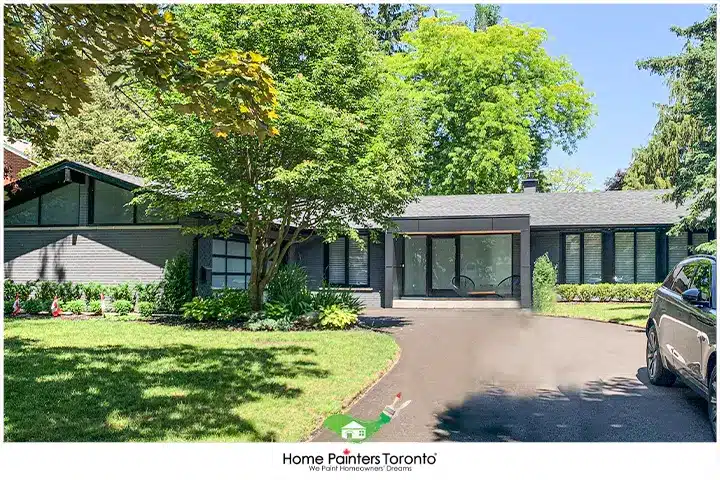
Condition of the wood:
The condition of the wood itself is also vital.
If it’s already starting to crack or split before you even begin painting, it will be much harder for the paint to hold up over time.
Quality of Exterior Paint:
The quality of your paint is another factor affecting how long the job will last. Cheap exterior paints fade or chip more easily than high-quality paints made with durable materials like acrylic and polyurethane. It’s crucial to use top-notch paints that have undergone professional testing.
Good Preparation:
Good preparation is key to ensuring your paint job lasts as long as possible. Good prep work means cleaning thoroughly and repairing damaged surfaces before painting.
If you prepare correctly, then your paint job will last. However, if you have good preparation, you should get about five to eight years, or even ten years, out of it before needing to start repainting over again.
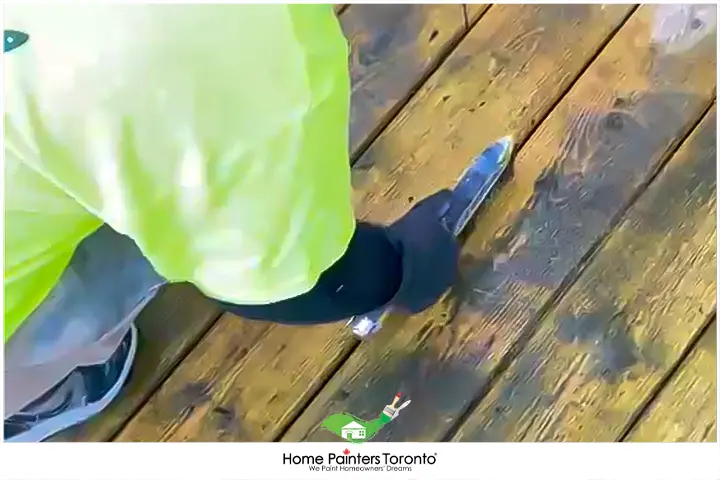
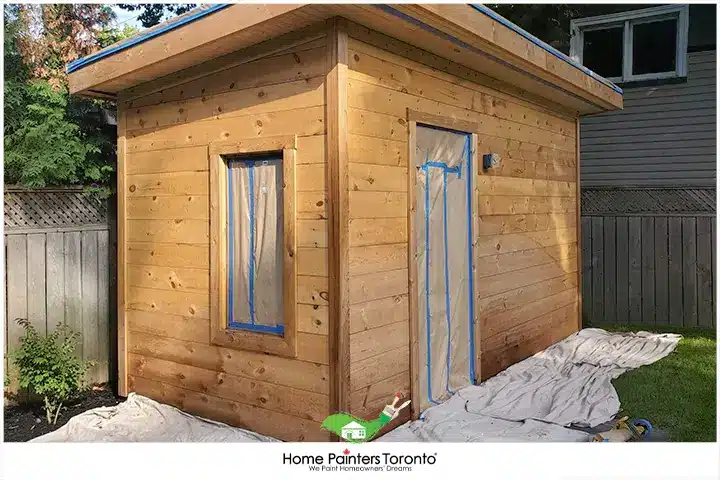
When Should I Repair the Wood, or When Should I Replace it Completely?
Almost always, you can tell if a piece of wood requires replacement if it is:
• rotting
• soggy or weak and blackened
• you can almost rip it away with your fingers
However, if it’s just a few small cracks or dents that are easy to fix, you should try to repair it rather than replace it altogether.
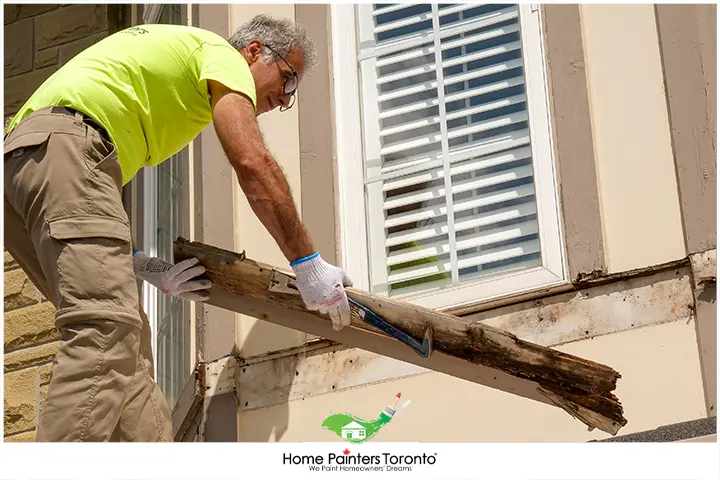
When Not To Paint Wood Exterior?
When you’re considering painting your wood, there are a few things to keep in mind:
1. Painting wood exteriors in cold weather is a no-no.
Cold weather below ten degrees can cause the paint to crack and peel, so it’s best to wait until you can get your project done in warmer temperatures.
2. Moisture is also bad for wood.
So you should avoid painting when it rains or if there’s been much moisture in the air recently. Water molecules have a different molecular structure than oil molecules. So they don’t adhere to the wood when wet—and then the paint will blister off.
3. Direct sunlight also harms your exterior paint job because it overheats the surface.
Excessive heat can ruin a paint job, causing the paint to peel or crack later. Aside from this, it’s not healthy to be outside during certain humid months of the year. Since the heat and humidity can cause skin rashes and other uncomfortable conditions
Can I Paint 100 Year Old Outdoor Wood?
Yes! However, remember that if your home is over a century old, it may have been repainted as many as ten or fifteen times and most of those coats were probably oil-based. This can make prepping and scraping off the previous paint much more labour-intensive.
So if you’re considering painting an old heritage home or curious if you can paint over stained wood, here are some things to keep in mind:
1. Scuff up the surface:
When painting an old surface, especially one that has been painted over multiple times with oil-based paint, it’s crucial to scuff it up first so your new paint will adhere better. You can do this with an orbital sander or by sanding it with a fine-grit sandpaper.
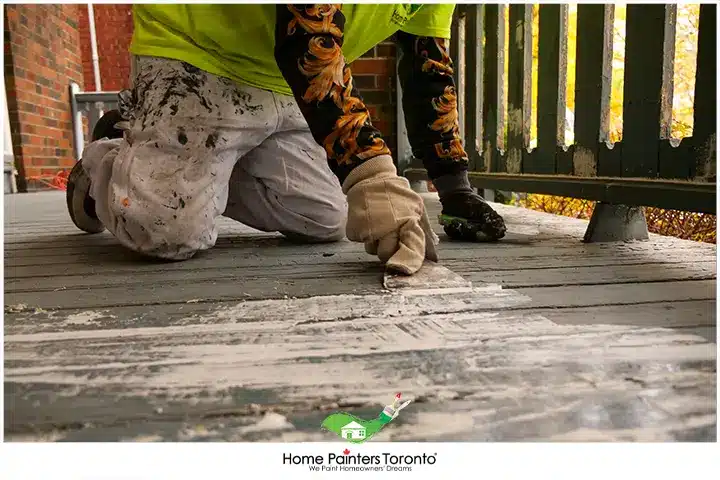
2. Make sure to use a suitable primer and paint.
It would be best always to use an exterior wood primer when painting an old surface. It will help adhesion and make it easier to cover up any imperfections on the surface.
Extreme Bond Primer by Sherwin Williams is designed to bond with old or any oil-based exterior primer works as well.
Then use an acrylic latex-based paint on top that will protect and beautify the surfaces for years to come.
3. When you paint older homes, sometimes you get what’s known as ‘Alligatoring.’
Alligatoring is when the paint cracks and splits, and it looks like an alligator’s skin, hence the name. This older paint often cracks and peels off as well.
If you find yourself with alligatoring, don’t panic! All you need to do is a good scraping, sanding, and caulking!
4. But if you have thick oil-based paint on your wood and want a “perfect” finish, hiring a restoration company to completely remove the paint may be your best option.
This can be a very gruelling, lengthy, and intricate process. So if you don’t have experience with it, you should leave it to the professionals!
Skilled paint restorers and exterior painters use chemicals, paint strippers, sanders, and paint removers to remove the old paint without damaging your wood. Also, this process can take a lot more time. So you can expect the price to be sometimes 2-4 times the cost of just prepping and painting it, depending on how many layers they need to strip.
Keep in mind, 98% of homeowners do not use this costly and lengthy process due to the difficulty level, cost, and expertise it takes to achieve such a finish.
Exterior Wood Restoration
In summary
Outdoor wood painting requires a lot of hard work and determination to see it through. It’s certainly not as straightforward or simple as painting indoors. But if you are willing to put in the effort for the sake of improving the outside of your home, then I can guarantee that it will really pay off.
But if you don’t have the time or energy, then perhaps hiring a professional painter would be the best option.
Most Interesting Blogs Related to
“Outdoor Wood Painting: Most Frequently Asked Questions About Outdoor Wood Painting”
We’d love to hear from you! If you’re looking for a professional painter to help with your exterior woodwork, please don’t hesitate to contact us today. Please give us a call at 416.494.9095, or email us at [email protected]. Also, don’t forget to follow us on all our social channels below!


